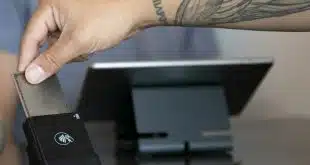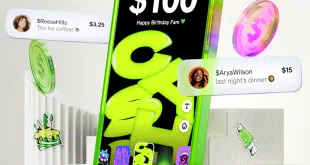By Kevin Woodward
Both QR codes and NFC have their backers and critics. But as mobile payments advance, which acceptance technology will own the future?
Merchants and the payments industry alike are vying to encourage more consumers to use contactless payments as a way to displace cash, know more about consumer purchasing behavior, and expedite the transaction process. The two most visible, and popular, technologies they use to accomplish those goals are quick-response codes and near-field communication.
Each of these technologies offers advantages and disadvantages over the other. The challenge is understanding what each can do, as well as each one’s long-term viability.
Quick-response codes, originally developed to track manufacturing parts, consist of square-shaped images with black lines that can represent a variety of information, such as the location of a point-of-sale terminal or fuel pump. They can also act as a loyalty-program identifier. QR codes are a one-way communication technology.
NFC’s two-way communication capability enables a device, like a smart phone, to connect to another NFC-enabled device, like a POS terminal, to share data. It forms the foundation of mobile-payment services like Apple Pay, Android Pay, and Samsung Pay.
The question, though, is not only which will win out, but also how payments companies should address the need to support one or both of these contactless technologies.
And there’s a still larger question, says Sherif Samy, managing director of the digital and transaction security business at UL, a Northbrook, Ill.-based testing company: why contactless payments is being pursued at all. Current contactless-payment services, whether using QR codes or NFC, are trying to make their services mainstream, he says.
“From that perspective, we’re trying to answer consumer demand,” says Samy. “Consumers want a ubiquitous, consistent experience at the point of sale, and have their payments accepted anywhere they go,” he says. Today’s current contactless-payments services, regardless of the technology, have not yet entered the mainstream, he says. “The mainstream adoption has not taken shape because we’re not answering the simple demands of our consumers,” Samy says.
The overall goals of the contactless-payment provider play a key role in which technology to use, says Jared Drieling, business intelligence manager at The Strawhecker Group, an Omaha, Neb.-based payments consultancy.
A service like Chase Pay, which incorporates technology from the QR code-based CurrentC mobile-payments service developed by the Merchant Customer Exchange LLC consortium, is a closed-loop system, he says, while the Apple Pay, Android Pay, and Samsung Pay services have a different goal. “They view their mobile wallets as another prong to get mobile users onto their operating systems,” Drieling says.
The QR Code
How do QR codes answer these demands? It depends on the situation, Samy says. For example, QR codes are not likely to show up as part of quick-service restaurant’s contactless-payments equipment. “The burger doesn’t have a bar code,” Samy says.
Instead, where QR codes appear to work better are in closed-loop, one-directional setups, he says. The poster child for such systems is Starbucks Corp.’s service. “The real reason Starbucks is successful is people don’t think about stealing a cup of coffee,” Samy says.
The one-direction aspect of QR codes is well suited to this trusted transaction between merchant and customer. “One of the two will generate a QR code and present it to the other,” he says. This works well in less risky scenarios, he says.
Indeed, QR codes have plenty of uses. “There’s still a niche play for QR codes,” says Drieling. “There are more use cases for retailers.”
Retailers already are geared to working with QR codes, Drieling says. Consumers are used to bar codes and scanning them at the checkout. “NFC is easy, but it’s not intuitive,” says Drieling, and almost every consumer has some type of experience with QR codes.
There are plenty of good reasons why QR codes are popular with retailers. Store staff, for example, needs little training to use contactless-payments services, such as Starbucks and Walmart Pay, that use QR codes, Drieling says.
Another pro for QR codes is that many retailers already have the compatible technology in their stores. “To access the QR code, there’s nothing special that needs to be done,” Drieling says.
But there are some disadvantages to relying on QR codes. While NFC devices operate by invisible radio waves, QR codes need a clear line-of-sight to function as intended. “For QR codes the environmental aspects are more important,” says Samy, “because we’re talking about optical technology.”
Factors such as the brightness of the mobile device’s screen, the quality of the screen, and the presence of a protective covering over the phone’s display may affect the ability to correctly, and quickly, read a QR code, he says.
But QR codes still remain popular with merchants, especially those with their own mobile-payment service. Walmart Pay and Kohl’s Pay rely on QR codes. These merchants control access to the transaction data and don’t have to train staff for a new payment-acceptance method.
The NFC Proposition
Efforts to promote the commercial viability of NFC technology began in 2004 with the formation of the NFC Forum, but it wasn’t until 10 years later that awareness of NFC slipped beyond its backers when Apple Inc. debuted Apple Pay, a heavily promoted mobile-payments service that relies on NFC.
NFC requires the two communication devices to be fewer than 4 centimeters (about 1.6 inches) from each other to successfully share data. In the case of Apple Pay, and Android Pay and Samsung Pay from Google Inc. and Samsung Electronics Co. Ltd., respectively, the data contains payment and consumer identification information. NFC enables each device to authenticate the other, a key capability not available with QR codes.
“When you look at NFC, it’s faster, easier to use, and offers a lot more flexibility,” Drieling says. He forecasts that NFC ultimately will be used more. Evidence to back up his claim comes from The Strawhecker Group’s data about EMV POS terminals. These devices in most instances also have NFC readers built in. “All of our devices have supported contactless for many years,” says Rod Hometh, senior vice president of strategic initiatives at POS-terminal maker Ingenico North America.
Strawhecker’s data shows that approximately 50% of the overall U.S. merchant base has EMV terminals. Of these, about 33% have the contactless feature activated, “but they’re correlating,” Drieling says. “We clearly see the contactless base being built out,” he says. While it varies across merchant types and geographic areas, the overall pace of contactless activation now almost mirrors that of EMV, he says. Indeed, estimates from the Berg Institute, a Sweden-based technology research firm, indicated there were 9.2 million NFC terminals in the United States and Canada at the end of 2016.
It is the two-way connectivity that makes NFC intriguing for merchants and payments companies. “The ability to tap-and-go quite literally is a significant advance,” Hometh says. “It’s a perceived advantage.”
Standardization of NFC technology also could propel it ahead of QR-code technology, Hometh says. QR codes, of course, also use standardization, but lack the richer data available in an NFC transaction.
This standardization is what makes it easy for multiple POS vendors to include NFC in their terminals and know that a consumer wielding an NFC payment device can make a transaction regardless of the terminal brand. “Standardization means you can open up the market much faster by getting products integrated and on merchant countertops,” Hometh says.
Another point for NFC is that the form factor is not restricted to one that can display or read a QR code. “NFC has the ability of being activated, or charged, in the field,” UL’s Samy says. “You can power an NFC ring from another device in the field. You can’t do that with QR codes.”
NFC as a contactless-payment method is gaining ground outside of the United States. In the United Kingdom, spending on contactless cards reached $4.2 billion in December, almost three times more than the year prior, says the UK Cards Association.
“In the U.S., we are still doing the EMV migration,” Samy says, “but at the same time there is more innovation on frictionless payments.”
The larger question to be answered by contactless payments, regardless of the technology, is how it becomes frictionless at the point of sale, Samy says, thus avoiding the terminal misreads, for example, that have plagued NFC-based mobile-payment services. If that can be accomplished, it will provide the consumer with a smooth experience, he says.
Drieling, too, suggests the future of contactless payments will be data rich, where payments, loyalty, and offers are integrated into a single contactless-payments transaction. “You can’t do that with QR codes,” Drieling says. “In the omnichannel world, that’s all going to be a contactless, two-way communication.”
Fill It Up: Using ExxonMobil’s Speedpass+ at the Pump
For a moment, I thought I was a thief.
For a split second as I drove away from the ExxonMobil fuel pump, I thought I forgot to pay. In actuality, I had just used the ExxonMobil Speedpass+ app to make a contactless payment for fuel for the first time.
ExxonMobil Corp. launched the app—notable because it enables consumers to use Apple Pay within the app after scanning a quick-response code to set their location at the pump—in 2016, and now more of its stations accept that payment method. The Speedpass+ app means consumers don’t have to dip their credit or debit cards into the pump’s card reader. It is available for iOS and Android devices. It works with Apple Pay and Samsung Pay.
In my experience, the process went smoothly, though the unfamiliarity of it impeded the overall experience. Because it’s a change in behavior, like using EMV chip cards to dip into a terminal instead of swiping a magnetic stripe one, it’s going to take some time for consumers to adopt it, and that’s assuming they know about it.
For me, my first instinct when I pulled up to the pump was to get my card out of my wallet and dip it in the reader. But I stopped myself because I had been wanting to use Speedpass+.
I opened the app and tapped the Pay for Fuel button in it. That triggered the iPhone’s camera app to open so I could scan a QR code pasted onto the pump. I confirmed I was at the correct pump and held my finger against the phone’s Touch ID sensor to authorize the transaction to pay with Apple Pay.
A notification appeared in the app that the pump was authorized, and the pump’s display said it was ready and to select a fuel grade. I did so and filled the car’s tank, returning the nozzle to the pump.
The receipt appeared in the app, and just before I drove off came the moment I thought I was driving away without paying. I double checked the receipt in the app; I was good to go.





